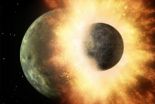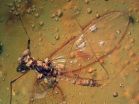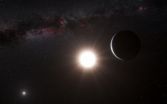(Press-News.org) It's a big claim, but Washington University in St. Louis planetary scientist Frédéric Moynier says his group has discovered evidence that the Moon was born in a flaming blaze of glory when a body the size of Mars collided with the early Earth.
The evidence might not seem all that impressive to a nonscientist: a tiny excess of a heavier variant of the element zinc in Moon rocks. But the enrichment probably arose because heavier zinc atoms condensed out of the roiling cloud of vaporized rock created by a catastrophic collision faster than lighter zinc atoms, and the remaining vapor escaped before it could condense.
Scientists have been looking for this kind of sorting by mass, called isotopic fractionation, since the Apollo missions first brought Moon rocks to Earth in the 1970s, and Moynier, PhD, assistant professor of Earth and Planetary Sciences in Arts & Sciences — together with PhD student, Randal Paniello, and colleague James Day of the Scripps Institution of Oceanography — are the first to find it.
The Moon rocks, geochemists discovered, while otherwise chemically similar to Earth rocks, were woefully short on volatiles (easily evaporated elements). A giant impact explained this depletion, whereas alternative theories for the Moon's origin did not.
But a creation event that allowed volatiles to slip away should also have produced isotopic fractionation. Scientists looked for fractionation but were unable to find it, leaving the impact theory of origin in limbo — neither proved nor disproved — for more than 30 years.
"The magnitude of the fractionation we measured in lunar rocks is 10 times larger than what we see in terrestrial and martian rocks," Moynier says, "so it's an important difference."
The data, published in the Oct. 18, 2012 issue of Nature, provide the first physical evidence for wholesale vaporization event since the discovery of volatile depletion in Moon rocks, Moynier says.
The Giant Impact Theory
According to the Giant Impact Theory, proposed in its modern form at a conference in 1975, Earth's moon was created in a apocalyptic collision between a planetary body called Theia (in Greek mythology the mother of the moon Selene) and the early Earth.
This collision was so powerful it is hard for mere mortals to imagine, but the asteroid that killed the dinosaurs is thought to have been the size of Manhattan, whereas Theia is thought to have been the size of the planet Mars.
The smashup released so much energy it melted and vaporized Theia and much of the proto-Earth's mantle. The Moon then condensed out of the cloud of rock vapor, some of which also re-accreted to the Earth.
This seemingly outlandish idea gained traction because computer simulations showed a giant collision could have created a Earth-Moon system with the right orbital dynamics and because it explained a key characteristic of the Moon rocks.
Once geochemists got Moon rocks into the lab, they quickly realized that the rocks are depleted in what geochemists call "moderately volatile" elements. They are very poor in sodium, potassium, zinc, and lead, says Moynier.
"But if the rocks were depleted in volatiles because they had been vaporized during a giant impact, we should also have seen isotopic fractionation," he says. (Isotopes are variants of an element that have slightly different masses.)
"When a rock is melted and then evaporated, the light isotopes enter the vapor phase faster than the heavy isotopes, so you end up with a vapor enriched in the light isotopes and a solid residue enriched in the heavier isotopes. If you lose the vapor, the residue will be enriched in the heavy isotopes compared to the starting material," explains Moynier.
The trouble was that scientists who looked for isotopic fractionation couldn't find it.
Extraordinary claims require extraordinary data
Asked how he felt when he saw the first results, Moynier says, "When you find something that is new and that has important ramifications, you want to be sure you haven't gotten anything wrong."
" I half expected results like those previously obtained for moderately volatile elements, so when we got something so different, we reproduced everything from scratch to make sure there were no mistakes because some of the procedures in the lab could conceivably fractionate the isotopes."
He also worried that fractionation could have occurred through localized processes on the moon, such as fire fountaining.
To make sure the effect was global, the team analyzed 20 samples of lunar rocks, including ones from the Apollo 11, Apollo 12, Apollo 15, and Apollo 17 missions — all of which went to different locations on the Moon — and one lunar meteorite.
To obtain the samples, which are stored in Houston at the Johnson Space Center, Moynier had to convince committee that controls access to them of the scientific merit of his project.
"'What we wanted were the basalts," Moynier says, "because they're the ones that came from inside the Moon and would be more representative of the Moon's composition."
But lunar basalts have different chemical compositions, Moynier says, including a wide range of titanium concentrations. Isotopes can also be fractionating during during the solidification of minerals from a melt. "The effect should be very, very tiny," he says, "but to make sure this wasn't what we were seeing, we analyzed both titanium-rich and titanium-poor basalts, which are at the two extremes of the range of chemical composition on the Moon."
The low and high titanium basalts had the same zinc isotopic ratios.
For comparison, they also analyzed 10 Martian meteorits. A few had been found in Antarctica but the others were from the collections at the Field Museum, the Smithsonian Institution and the Vatican.
Mars, like the Earth, is very rich in volatile elements, Moynier says. "Because there is a decent amount of zinc inside the rocks, we only needed a tiny bit to test for fractionation, and so these samples were easier to get."
What it means
Compared to terrestrial or martian rocks, the lunar rocks Moynier and his team analyzed have much lower concentrations of zinc but are enriched in the heavy isotopes of zinc.
Earth and Mars have isotopic compositions like those of chondritic meteorites, which are thought to represent the original composition of the cloud of gas and dust from which the solar system formed.
The simplest explanation for these differences is that conditions during or after the formation of the Moon led to more extensive volatile loss and isotopic fractionation than was experienced by Earth or Mars.
The isotopic homogeneity of the lunar materials, in turn, suggests that isotopic fractionation resulted from a large-scale process rather than one that operated only locally.
Given these lines of evidence, the most likely large-scale event is wholesale melting during the formation of the Moon. The zinc isotopic data therefore supports the theory that a giant impact gave rise to the Earth-Moon system.
"The work also has implications for the origin of the Earth," Moynier points out, "because the origin of the Moon was a big part of the origin of the Earth."
Without the stabilizing influence of the Moon, the Earth would probably be a very different sort of place. Planetary sciences think the Earth would spin more rapidly, days would be shorter, weather more violent, and climate more chaotic and extreme. In fact it might have been such a harsh world, it would have been unfit for the evolution of our favorite species: us.
INFORMATION:
Proof at last: Moon was created in giant smashup
Wholesale vaporization of impactor left signature in tiny excess of heavier form of zinc
2012-10-18
ELSE PRESS RELEASES FROM THIS DATE:
Giant impact scenario may explain the unusual moons of Saturn
2012-10-18
SANTA CRUZ, CA--Among the oddities of the outer solar system are the middle-sized moons of Saturn, a half-dozen icy bodies dwarfed by Saturn's massive moon Titan. According to a new model for the origin of the Saturn system, these middle-sized moons were spawned during giant impacts in which several major satellites merged to form Titan.
Erik Asphaug, professor of Earth and planetary sciences at the University of California, Santa Cruz, will present this new hypothesis October 19 at the annual meeting of the Division for Planetary Sciences of the American Astronomical ...
The evolutionary origins of our pretty smile
2012-10-18
It takes both teeth and jaws to make a pretty smile, but the evolutionary origins of these parts of our anatomy have only just been discovered, thanks to a particle accelerator and a long dead fish.
All living jawed vertebrates (animals with backbones, such as humans) have teeth, but it has long been thought that the first jawed vertebrates lacked pearly gnashers, instead capturing prey with gruesome scissor-like jaw-bones.
However new research, led by the University of Bristol and published today in Nature, shows that these earliest jawed vertebrates possessed teeth ...
Epigenetic analysis of stomach cancer finds new disease subtypes
2012-10-18
DURHAM, N.C. – Researchers at the Duke-NUS Graduate Medical School in Singapore have identified numerous new subtypes of gastric cancer that are triggered by environmental factors.
Reported in the Oct. 17, 2012, issue of the journal Science Translational Medicine, the findings are based on the science of epigenetics, a study of gene activity. The insights into the complexities of stomach cancer could lead to better treatment approaches for the second leading cancer killer in the world, behind lung cancer.
"Gastric cancer is a heterogenous disease with individual patients ...
Physical activity shown to help young and elderly alike with lower-leg coordination
2012-10-18
An Indiana University study that examined the effect of age and physical activity on lower leg muscle reflexes and coordination concluded that participation in physical activity was beneficial for lower leg muscle coordination across both sides of the body in both young and older study participants. Lower limb muscle communication is essential for everyday tasks, such as walking, balancing, and climbing stairs.
"The results of this study suggest that participation in physical activity contributes to greater crossed-spinal reflex stability in both young and elderly subjects," ...
Springtail bugs may have travelled on the wings of mayflies
2012-10-18
A mayfly trapped in 16-million-year-old-amber reveals a hitchhiking springtail, a wingless arthropod that is amongst the most commonly found bugs all over the world. The new research, published Oct 17 in the open access journal PLOS ONE led by David Penney from the University of Manchester, UK, is the first to show that springtails travelled on winged insects like mayflies, and only the second example of this mode of travel by springtails in the past or present.
Springtails are among the most abundant group of arthropods, found in large numbers in soil all over the world. ...
Dolphins can remain alert for up to 15 days at a time with no sign of fatigue
2012-10-18
Dolphins sleep with only one half of their brains at a time, and according to new research published Oct. 17 in the open access journal PLOS ONE, this trait allows them to stay constantly alert for at least 15 days in a row. Brian Branstetter from the National Marine Mammal Foundation and colleagues found that dolphins can use echolocation with near-perfect accuracy continuously for up to 15 days, identifying targets and monitoring their environment.
The researchers studied 2 dolphins, one male and one female, and found that they were capable of this task with no signs ...
Impact of autism may be different in men and women
2012-10-18
Men and women with autism spectrum conditions (ASC) may show subtle but significant differences in the cognitive functions impacted by the condition, according to new research published Oct 17 by Meng-Chuan Lai and colleagues from the Autism Research Centre at the University of Cambridge, UK in the open access journal PLOS ONE.
Though individuals with autism show sex-specific differences in serum biomarkers, genetics and brain anatomy, little is known about any sex-dependent differences in cognition caused by ASC. Following their previous report on behavioral sex differences ...
Children with autism can identify misbehavior but have trouble putting it in words
2012-10-18
Children with autism have difficulty identifying inappropriate social behavior, and even when successful, they are often unable to justify why the behavior seemed inappropriate. New brain imaging studies show that children with autism may recognize socially inappropriate behavior, but have difficulty using spoken language to explain why the behavior is considered inappropriate, according to research published Oct. 17 in the open access journal PLOS ONE by Elizabeth Carter from Carnegie Mellon University and colleagues.
The authors say the results of their functional ...
Crows don't digest prions, may transport them to other locations
2012-10-18
Crows fed on prion-infected brains from mice can transmit these infectious agents in their feces and may play a role in the geographic spread of diseases caused by prions, such as chronic wasting disease or scrapie. The new research published Oct. 17 in the open access journal PLOS ONE by Kurt VerCauteren from the US Department of Agriculture (USDA) and other colleagues, shows that prions can pass through crows' digestive systems without being destroyed, and may be excreted intact after ingestion by the birds. According to the authors, their results demonstrate a potential ...
Planet found in nearest star system to Earth
2012-10-18
European astronomers have discovered a planet with about the mass of the Earth orbiting a star in the Alpha Centauri system — the nearest to Earth. It is also the lightest exoplanet ever discovered around a star like the Sun. The planet was detected using the HARPS instrument on the 3.6-metre telescope at ESO's La Silla Observatory in Chile. The results will appear online in the journal Nature on 17 October 2012.
Alpha Centauri is one of the brightest stars in the southern skies and is the nearest stellar system to our Solar System -- only 4.3 light-years away. It is ...
LAST 30 PRESS RELEASES:
Numbers in our sights affect how we perceive space
SIMJ announces global collaborative book project in commemoration of its 75th anniversary
Air pollution exposure and birth weight
Obstructive sleep apnea risk and mental health conditions among older adults
How talking slows eye movements behind the wheel
The Ceramic Society of Japan’s Oxoate Ceramics Research Association launches new international book project
Heart-brain connection: international study reveals the role of the vagus nerve in keeping the heart young
Researchers identify Rb1 as a predictive biomarker for a new therapeutic strategy in some breast cancers
Survey reveals ethical gaps slowing AI adoption in pediatric surgery
Stimulant ADHD medications work differently than thought
AI overestimates how smart people are, according to HSE economists
HSE researchers create genome-wide map of quadruplexes
Scientists boost cell "powerhouses" to burn more calories
Automatic label checking: The missing step in making reliable medical AI
Low daily alcohol intake linked to 50% heightened mouth cancer risk in India
American Meteorological Society announces Rick Spinrad as 2026 President-Elect
Biomass-based carbon capture spotlighted in newly released global climate webinar recording
Illuminating invisible nano pollutants: advanced bioimaging tracks the full journey of emerging nanoscale contaminants in living systems
How does age affect recovery from spinal cord injury?
Novel AI tool offers prognosis for patients with head and neck cancer
Fathers’ microplastic exposure tied to their children’s metabolic problems
Research validates laboratory model for studying high-grade serous ovarian cancer
SIR 2026 delivers transformative breakthroughs in minimally invasive medicine to improve patient care
Stem Cell Reports most downloaded papers of 2025 highlight the breadth and impact of stem cell research
Oxford-led study estimates NHS spends around 3% of its primary and secondary care budget on the health impacts of heat and cold in England
A researcher’s long quest leads to a smart composite breakthrough
Urban wild bees act as “microbial sensors” of city health.
New study finds where you live affects recovery after a hip fracture
Forecasting the impact of fully automated vehicle adoption on US road traffic injuries
Alcohol-related hospitalizations from 2016 to 2022
[Press-News.org] Proof at last: Moon was created in giant smashupWholesale vaporization of impactor left signature in tiny excess of heavier form of zinc



